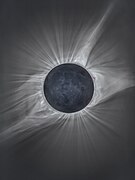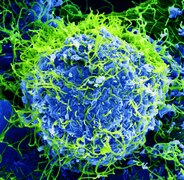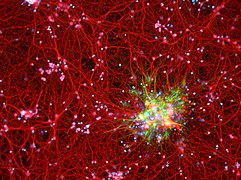Wikipedia:Wiki Science Competition 2017 in the United States
-
Beautiful... But Deadly, a colorized scanning electron micrograph of Ebola virus particles budding from an infected monkey kidney cell, by John Bernbaum
-
Evolution of a Tornado, a photomontage of the formation of a tornado north of Minneola, Kansas on May 24, 2016, by Jason Weingart
-
Mantis Fly, a black-and-white film macrophotograph of a live mantisfly found in the Santa Rita Mountains of Arizona in August 1963, by Ron Sterling
-
The Galaxy Within, a 10x image of cultured mouse cortical neurons and astrocytes in cell culture, by Dustin Johnsen
The results are in! The five U.S. Jury's Choice winners are displayed above; see the results announcement for more information and to see the other 20 national finalists. Five photographs from the U.S. were selected as international runners-up in their categories: Total Solar Eclipse, Beautiful... But Deadly, and Evolution of a Tornado pictured above, as well as Birefringent Water Ice and Microscope Images with Polarized Light. See the international results announcement for the full list of winners and runners-up. Thanks to all participants for their submissions!
The Wiki Science Competition is an international science photography competition being held in November 2017. Wikimedia District of Columbia is organizing the United States arm of the competition. The competition was first organized in Estonia, expanded to all of Europe in 2015, and is coming to the rest of the world this year!
To participate, you must be the author of photos you upload, and must have the rights to upload them. The photos should be of a good quality and size, and need to have a good description including what the image depicts, how and where it was made, and what is important to notice about it. It is encouraged to add the images to appropriate Commons categories. For more details, see the full international rules.
See all photographs uploaded from the U.S.! Use the hashtags ![]() #WSC2017 #WikiScience #WikiScience2017 to spread the word about the competition!
#WSC2017 #WikiScience #WikiScience2017 to spread the word about the competition!
Categories and prizes[edit]
The competition is divided into five categories. The U.S. jury will select five finalists from each category to submit to the international competition. The categories are:
- People in science. Got a photograph of a Nobel Prize winner you've always been wanting to upload? Or your dissertation advisor? Or your benchmate? We want your photos of scientists!
- Microscopy. Photos of small things can be big contributions!
- Non-photographic media. We know you have a really cool diagram you made, or a computer-generated image, or even audio or video of a research result or a scientific method being performed.
- Image sets. Because sometimes, just one isn't enough. This category is for sets of up to ten thematically linked images.
- General. Everything else: archaeology, zoology, astronomy, X-ray images, ...
Wikimedia District of Columbia is sponsoring five "Jury's Choice" prizes of US$200 each.
Can I upload that photograph?[edit]
Determining the copyright status of images can be tricky. The guidance should tell you whether you can upload your photograph. If you have any questions, please contact us on the talk page. Note that these guidelines are U.S.-specific and may not apply to other countries.
- In general, publication status determines whether you can upload an image.
- If the image is unpublished, you generally have the rights to upload it. University and government intellectual property agreements usually do not cover copyright in text or images. If you work for a for-profit company, check with your employer.
- If the image is published in a journal, you need to check the journal's copyright agreement. When you publish in a journal, you usually transfer the copyright to them, and you no longer own the rights to the images. The exceptions are if the article is published under an acceptable Creative Commons or other free-content license (such as PLOS journals), or under an arrangement where you retain copyright (such as Nature journals). Additionally, authors usually retain the copyright to Supplementary Information documents, so you can upload those. SHERPA/RoMEO is a tool that can tell you the copyright status of articles submitted to any scientific journal.
- However, there are some types of images that can always be uploaded regardless of publication status.
- If you are an employee of the U.S. federal government or certain states, images you create as part of your job are in the public domain and can be uploaded regardless of their publication status. This does not apply to contractors, and it does not apply if any non-employees were co-authors of the image. Two states place their employees' works in the public domain, California and Florida. Note that there are some Florida agencies that are exceptions to this, including all state universities and colleges; see Template:PD-FLGov for a full list.
- Some types of images are never eligible for copyright. These are images that do not meet the threshold of human creativity required by U.S. copyright law, usually because they are too simple, represent commonly known data, or are products of nature. Examples include chemical structural formulas, medical diagnostic images, diagrams of knots, and monkey selfies. Please use the appropriate copyright tag when uploading these images.
Jury[edit]
The jury for the U.S. competition is:
- John P. Sadowski, member of the Board of Directors, Wikimedia District of Columbia
- Sandy Avila, Science Librarian, University of Central Florida
- Esther Jackson, Public Services Librarian, New York Botanical Garden
- Ryan McGrady, Community Engagement Manager, Wiki Education Foundation
- Ian Ramjohn, Wikipedia Content Expert, Sciences, Wiki Education Foundation
- Laura Soito, Physical Sciences Librarian, University of New Mexico.






